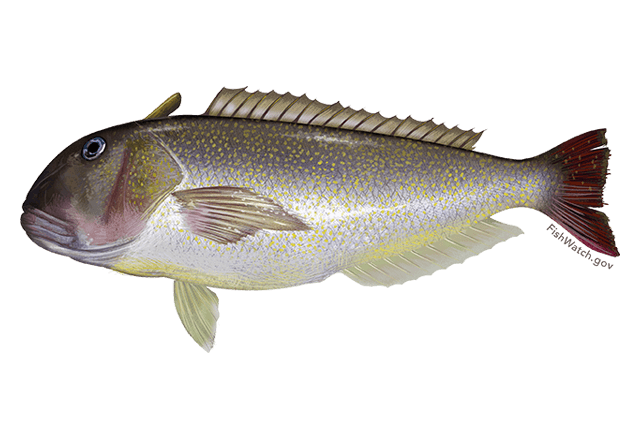Great Northern Tilefish

Species Details
Lopholatilus Chamaeleonticeps
Malacanthidae
Perciformes
Nearshore, Offshore, Sandy or Muddy Ocean Floor
40 - 66 lbs.
33" - 49"
Great Northern Tilefish (Lopholatilus chamaeleonticeps) Fish Description
Also known as the Golden Tile, the Great Northern Tilefish is the biggest member of the Malacanthidae family (compare it with the Atlantic Goldeneye Tilefish, and the Blackline Tilefish).
What makes this distinct from its relatives is the remarkable crest and large adipose flap on its head. The body of the Great Northern Tilefish is blue-green, and its belly, white. During spawning season, the color of its head turns pinkish from being light blue. The area underneath its eyes has a blue hue.
The extreme ends of its anal fin are purplish-blue, while its pectoral fins are sepia-colored.
Diet and Size
The major part of the Great Northern Tilefish’s diet is zooplankton. Both young and adult ones feed on fishes, crustaceans, and benthic invertebrates. They also like herring (see Atlantic Herring, and Pacific Herring), hagfish, mackerel (see Atlantic Mackerel, Cero Mackerel, King Mackerel, Spanish Mackerel, and Chub Mackerel), Atlantic dogfish, squid, and bivalve mollusks.
Great Northern Tilefish can grow between 38 to 44 inches on average. Males are larger than females who only measure up to 39 inches in length. They can live around 25 to 35 years. Female Great Northern Tilefish tend to live longer than males.
Interesting Facts About the Great Northern Tilefish
- Great Northern Tilefish live long and grow up slowly.
- Juvenile Great Northern Tilefish make their own burrows in the sediments. They keep the burrows for the rest of their lives.
- During the mating season, each female lays about 2.3 million eggs.
- This species was discovered in the year 1879 when it was captured by chance by a cod trawler on the coast of Massachusetts.
- George Brown Good and Tarleton Hoffman Bean named the Great Northern Tilefish Lopholatilus chamaeleonticeps in 1896.
- When cooked, the Great Northern Tilefish is called the “golden tile”, referring to the large yellow spots on its pink sides and blue-green back.
- The oldest Great Northern Tilefish recorded was a 46-year old female that measured 33.5 inches; the oldest male lived up to 29 years old only but measured 41.3 inches.
Fishing Techniques
To catch Great Northern Tilefish, find a soft muddy bottom around 600 to 800 feet deep and fish for them there. Drop a lead to the bottom; this will serve as a stimulus, making them so curious as to approach it. Powered reels and wire lines are also sometimes used to capture Great Northern Tilefish, especially by charter boat anglers. Use baits like pieces of barracuda, mackerel, squid, tuna, and bonito.
Regulations have been put in place to prevent overfishing of the Great Northern Tilefish. The limitations include gear restrictions and catch limits to avoid damaging their natural habitats. Due to these measures, their population increased around a decade ago.
However, studies have observed that their average size now has significantly decreased compared to those observed in the 1980s.
Habitat and Distribution
Great Northern Tilefish are generally abundant in the waters of the Atlantic Ocean, from Nantucket Shoals and Georges Bank to the East Coast and the Gulf of Mexico. They live in waters as deep as 300 to 480 feet with temperatures around 76 °F to 78 °F.
Some reports, however, state that Great Northern Tilefish stay at the bottom as deep as 250 to 1,500 feet with temperatures ranging from 49 °F to 58 °F. The decline in the population of this species could be a serious threat to the symbiosis in the continental shelf not only for the Great Northern Tilefish but also the other organisms that use their burrows as shelter.
In 2007, certain states decreased the allowable limit for the number of Great Northern Tilefish caught by one third.







